USGBC and the Future of Sustainable Building Standards
Every building has a story. When I first saw a LEED-certified office in San Francisco, I got it. Buildings are not just structures. They are living, breathing ecosystems that show our care for the planet.
The green building council is more than a group. It’s a movement changing how we build. Sustainable building has moved from being rare to being common in our architecture.
Your view of building is about to shift. The United States Green Building Council (USGBC) is leading the way. They are setting new standards that challenge old ways of building. They push for more environmental responsibility and new ideas in design.
Key Takeaways
- USGBC drives transformative change in sustainable building practices
- Green building standards represent a holistic approach to environmental design
- Sustainable architecture is becoming increasingly important in urban development
- Building certifications provide tangible metrics for environmental performance
- Technological innovations are accelerating sustainable construction methods
Understanding USGBC’s Role in Modern Sustainable Architecture
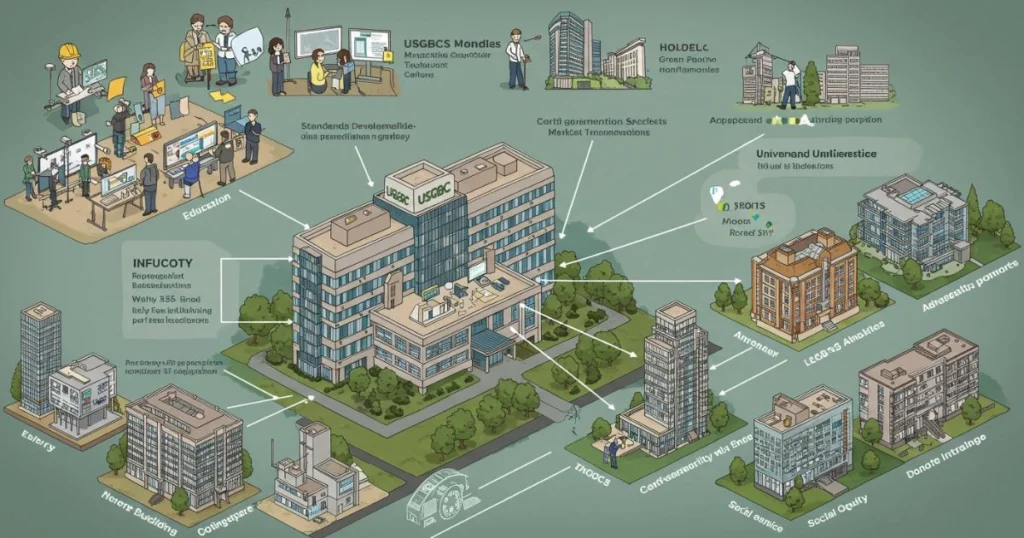
The green buildings council has changed how we design buildings. It fights for sustainable practices. The United States Green Building Council (USGBC) leads in making construction and design better for the planet.
Sustainable architecture is more than a trend. It’s a key answer to our environmental problems. Green buildings help cut down carbon emissions and build better infrastructure.
Origins and Emergence
The green buildings council started in the early 1990s. It was formed by architects, builders, and environmental experts. They aimed to set new standards for buildings and nature.
- Started in 1993 as a non-profit
- Works to promote green building practices
- Created new certification systems
Core Mission and Strategic Vision
The USGBC wants to change the built world. They aim to lead with green building standards. Their goals include:
- Lowering the environmental impact of buildings
- Supporting energy-efficient designs
- Encouraging smart use of resources
Global Sustainable Development Impact
The council’s green standards have changed construction globally. Their certifications set the standard for sustainable design. They motivate architects and developers to care for the environment.
“Sustainable architecture is not just about buildings, but about creating healthier environments for future generations.”
The USGBC keeps pushing for change in building design and construction. They innovate and stay committed to a greener future.
The Evolution of LEED Certification Systems
The Leadership in Energy and Environmental Design (LEED) certification has changed the green building world a lot. The USGBC, as a top green building advisor, has made this rating system better over time. They’ve updated it to tackle new environmental issues and tech advancements.
LEED has seen big changes to keep up with sustainable building needs. From its first versions to LEED v4.1 now, it’s gotten much better at checking how buildings perform and their environmental effects.
- LEED v1: Initial framework for green building standards
- LEED v2: Enhanced criteria for environmental performance
- LEED v3: Introduced more detailed evaluation metrics
- LEED v4: Focused on material transparency and performance
- LEED v4.1: Brought in digital integration and overall sustainability
Now, your building design can use these advanced certification levels. Each update has made a big step forward in green construction. It encourages architects and developers to go beyond old building ways.
“LEED certification is not just a standard – it’s a commitment to environmental stewardship and innovative design.” – USGBC Leadership
The green building advisor community sees LEED as more than a rating system. It’s a full framework that encourages new ideas, cuts down on environmental harm, and makes better spaces for people.
As building tech keeps getting better, LEED will keep up. It will stay the top standard for green construction worldwide.
Key Components of Green Building Standards Today
The green building council has changed how we build by setting strict standards. These standards make buildings more sustainable. They use new technologies and eco-friendly methods.
Building green is more than just building. The green building council has set tough rules. These rules cover many ways to be better for the environment.
Energy Efficiency Requirements
Energy efficiency is key in green building. Builders use many ways to cut down energy use:
- Advanced insulation techniques
- High-efficiency HVAC systems
- Integrated renewable energy solutions
- Smart building automation technologies
“Reducing energy consumption is not just an environmental imperative, but an economic opportunity” – USGBC Research Team
Water Conservation Metrics
Water management is also very important in green building. New ideas include:
- Low-flow plumbing fixtures
- Rainwater harvesting systems
- Greywater recycling infrastructure
- Drought-resistant landscaping
Material Selection Criteria
Choosing the right materials is key. They must be good for the environment, last long, and be safe for people. Green buildings look for materials that:
- Minimize carbon footprint
- Support local manufacturing
- Promote occupant wellness
- Enable future recycling
The green building council’s standards help make construction better for the planet.
How Digital Technology is Reshaping Sustainable Building Practices
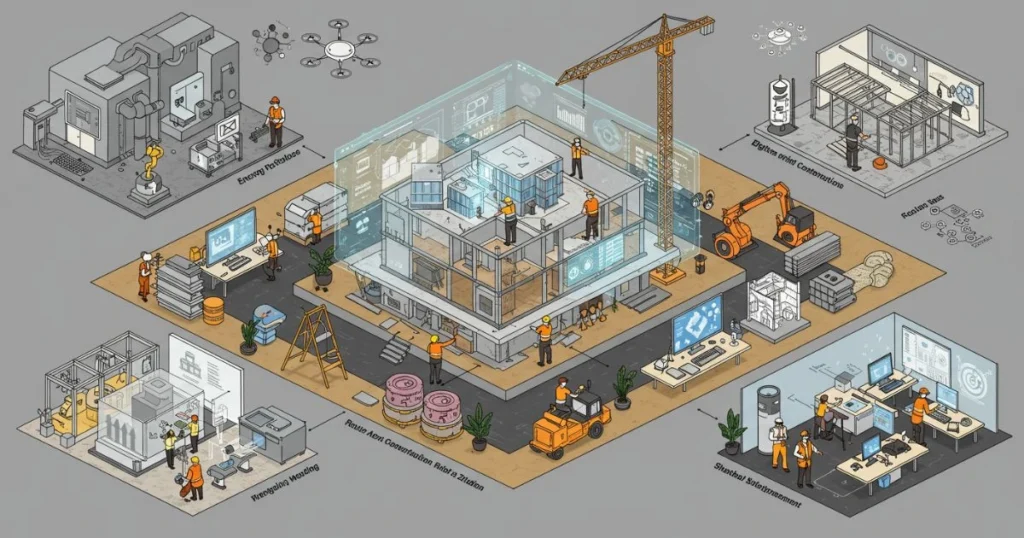
Digital technology is changing how green buildings council works on sustainable construction. New tech is making buildings smarter and more efficient. This helps reduce harm to the environment.
Today’s building tech offers big chances for being green. Some key areas include:
- Building Information Modeling (BIM) for better design
- Internet of Things (IoT) sensors for constant checks
- Artificial intelligence for better energy use
Now, we can track and boost our buildings’ performance like never before. Smart tech lets us collect data in real-time. This helps experts make better choices about using resources and saving energy.
The green buildings council sees these tech advances as key for a greener future. Digital tools help with:
- Forecasting maintenance needs
- Optimizing energy use
- Lowering waste
By using the latest digital solutions, buildings are getting smarter and greener. These techs cut down on carbon emissions and make spaces better for people.
“Technology is the key to unlocking sustainable building practices of the future.” – Clean Energy Research Institute
Environmental Impact Assessment Methods in Modern Construction
Green building advisors are key in making construction more sustainable. They help reduce harm to the environment. Now, all construction projects must do detailed environmental checks to protect our planet.
Looking at green buildings means checking many important areas. We need careful planning and analysis to lessen our impact on nature.
Carbon Footprint Measurement
Tracking carbon emissions is now a must in building assessments. Experts use new methods to measure carbon. They look at:
- Embodied carbon calculations
- Operational carbon tracking
- Energy consumption analysis
- Material sourcing evaluations
Waste Management Protocols
Good waste management is vital for green buildings. They use smart ways to cut down waste and recycle more. This includes:
- Detailed waste stream mapping
- On-site recycling programs
- Material reuse initiatives
- Sustainable disposal techniques
Ecosystem Conservation Strategies
Keeping local habitats safe needs careful planning. Green advisors work on plans that protect nature while building. They focus on:
- Biodiversity protection
- Habitat restoration
- Minimal site disruption
- Native landscape integration
By using these detailed methods, buildings can greatly lessen their harm to the environment. This way, we build in a way that’s good for our planet.
The Economic Benefits of Green Building Certification
Getting your building certified green can save you money. The green building council shows that going green can also make you money. It’s not just good for the planet.
When you get your building certified, you open up many ways to save:
- Reduced Operating Costs: Green buildings use 30-50% less energy than old ones
- Higher Property Values: Green buildings sell for more
- Increased Tenant Attraction and Retention
- Potential Tax Incentives and Rebates
There’s more to it than just saving money at first. You’ll see real savings over time. These include:
- Lower utility bills
- Being more competitive in the market
- Better work environments
- Less money spent on repairs
Studies show green buildings can get you 10% more rent and have fewer empty spaces. By using green design, you’re not just helping the planet. You’re also making a wise financial choice.
Green buildings represent the future of intelligent, cost-effective real estate development.
Emerging Trends in Sustainable Building Design
The green buildings council is leading the way in sustainable architecture. They are exploring new designs and technologies. This is in response to growing environmental challenges.
Today’s green buildings use advanced methods that go beyond old practices. These trends aim to create spaces that are good for the planet and people. They also make buildings more efficient.
Biophilic Design Integration
Biophilic design is a new way to design buildings. It connects people with nature by:
- Living green walls
- Natural lighting strategies
- Indoor plant integration
- Organic material selections
This design improves mental health, productivity, and happiness in green buildings.
Smart Building Technologies
Smart systems are changing how buildings work. They use advanced sensors and AI to:
- Monitor energy in real-time
- Control the climate automatically
- Do predictive maintenance
- Adjust lighting
Net-Zero Energy Solutions
The goal is to make buildings use no energy at all. This means creating buildings that produce as much energy as they use. They do this with:
- Solar panels
- Advanced insulation
- Renewable energy
- Efficient systems
These new ideas show the green buildings council’s dedication to a greener future.
Regulatory Compliance and Building Code Updates
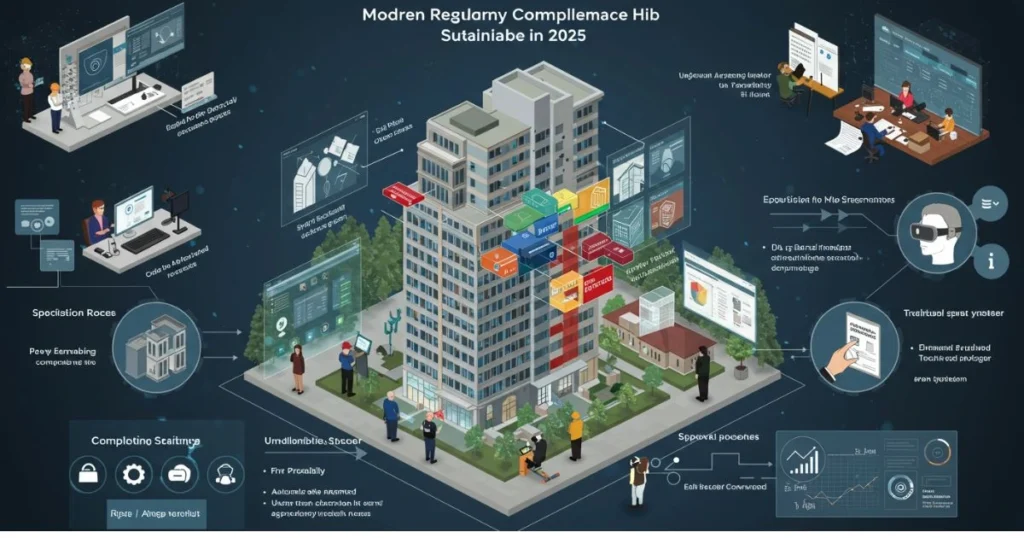
Understanding sustainable building rules is complex. A green building advisor is key in helping projects meet new environmental standards. Building codes have changed a lot, pushing for more sustainable designs and energy use.
In the United States, construction rules have changed a lot. Important changes include:
- Stricter energy performance standards
- Enhanced water conservation requirements
- More rigorous materials sustainability criteria
Success in your project depends on knowing these rules well. A green building advisor can help you:
- Understand local and national building codes
- Plan how to follow these codes
- Spot any challenges in following the rules
“Sustainable building is no longer optional—it’s becoming a fundamental requirement in modern construction,” says leading environmental architect Sarah Martinez.
LEED certification helps projects go beyond basic rules. With green building experts, you can turn following rules into a project strength.
Implementing USGBC Standards in New Construction Projects
Building green buildings is complex. It needs a careful plan that follows the green building council’s strict rules. Success in green construction comes from good planning, precise work, and ongoing checks.
Starting a new project means you must understand the USGBC framework. This is key for making buildings that are good for the environment and meet today’s green standards.
Project Planning Phase
The first step in using green building standards is to prepare well:
- Do a full site check
- Plan sustainable designs
- Make detailed plans for environmental impact
- Set clear goals for sustainability
Construction Management
Green buildings need careful management during building:
- Choose materials that are good for the planet
- Reduce waste during building
- Use energy wisely
- Keep track of how green the building is
Post-Occupancy Evaluation
Your green commitment doesn’t stop after the building is done. Checking the building after it’s used makes sure it stays green and meets its goals.
Sustainable construction is not a destination, but a continuous journey of environmental responsibility.
By using these steps, you can put USGBC standards into action. This helps make our built world more sustainable.
Future Innovations in Green Building Certification
The green buildings council is changing sustainable architecture fast. As climate issues grow, building standards are getting better. They now meet complex environmental and social needs.
New technologies are changing sustainable building. Key innovations include:
- Advanced materials that can heal themselves and capture carbon
- AI systems that optimize energy use
- Designs that can adapt to climate changes
- Metrics that measure social equity in buildings
Understanding green building certification needs to grow. Future standards will include:
- Tracking carbon footprint fully
- Considering wellness and occupant health
- Using technologies to monitor building performance
Renewable energy and smart building tech are changing things a lot. The green buildings council is creating new paths for sustainable design. This encourages architects and developers to make buildings that are more responsive and adaptable.
The future of building certification is about making buildings that can adapt and respond to needs.
These new trends show a big change towards smarter, more complete sustainable building. They focus on taking care of the environment and improving human experience.
Global Adaptation of Sustainable Building Standards
Green building practices are changing how we build around the world. Each continent has its own way of doing things. Green building advisors help by understanding international standards and local challenges.
Building green looks different everywhere, because of local environments, economies, and cultures. Knowing these differences helps experts create better sustainable designs.
Regional Variations in Sustainability
Different places have their own views on green building:
- European countries focus on saving energy and using renewable sources
- Asian cities aim for dense, sustainable urban areas
- Middle Eastern areas concentrate on saving water
- In North America, technology and nature go hand in hand
International Collaboration Efforts
Global groups are teaming up to make green building standards the same everywhere. This teamwork helps:
- Make sustainability measurements consistent
- Exchange top green building ideas
- Develop new green building tech
Cultural Considerations in Green Design
Culture plays a big role in green building. A green building advisor needs to know local tastes, building styles, and environmental issues.
For global sustainability to work, we need to be flexible, respectful of cultures, and open to new ideas.
Conclusion
The green building council’s journey is key to changing how we build and design. Learning about sustainable building can help protect our environment and improve community health. As the building world grows, green design is more important than ever for strong, efficient buildings.
Green building standards are now a must for responsible building. By using LEED certification, architects and developers can lessen environmental harm. They also create healthier places to live and work. The green building council shows how new designs can solve big environmental problems.
Your part in this change is big. Keeping up with new tech, supporting green building, and choosing sustainable options can lead to real change. Every choice to focus on the environment in building design helps build better, greener communities in the U.S.
The future of building is green. As tech improves and awareness grows, the building world will keep pushing limits. By following these standards, you join a global effort for better, greener, and more responsible building.
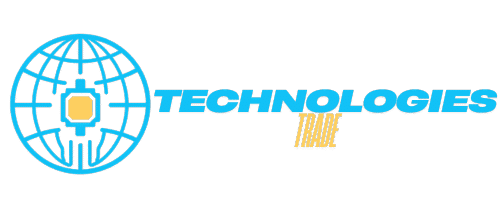
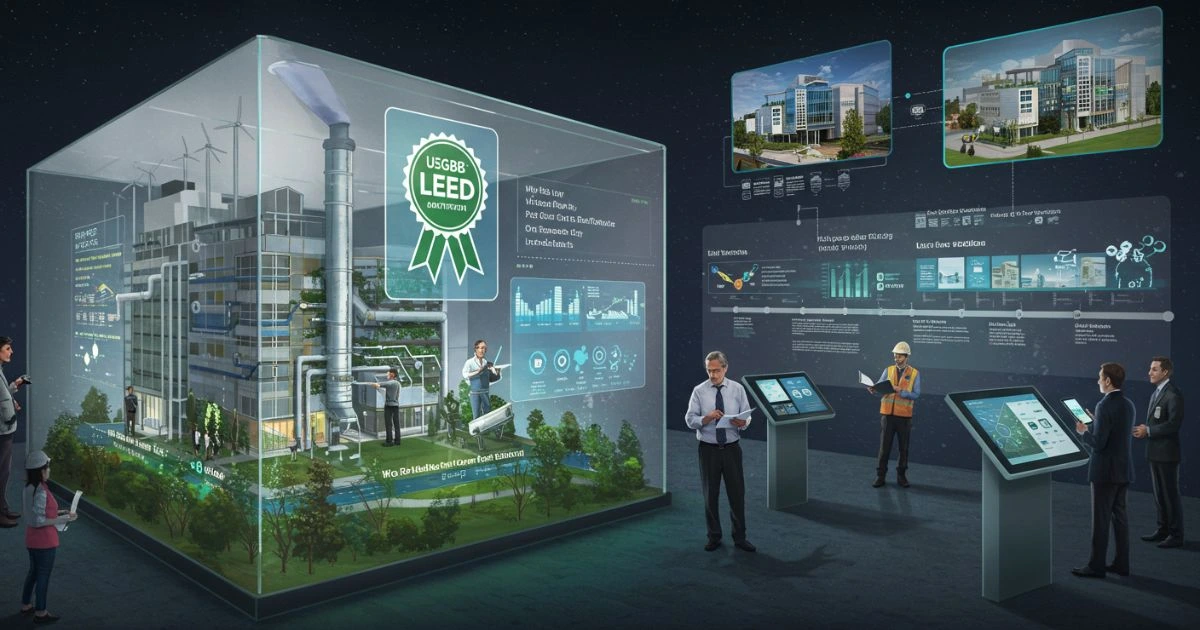

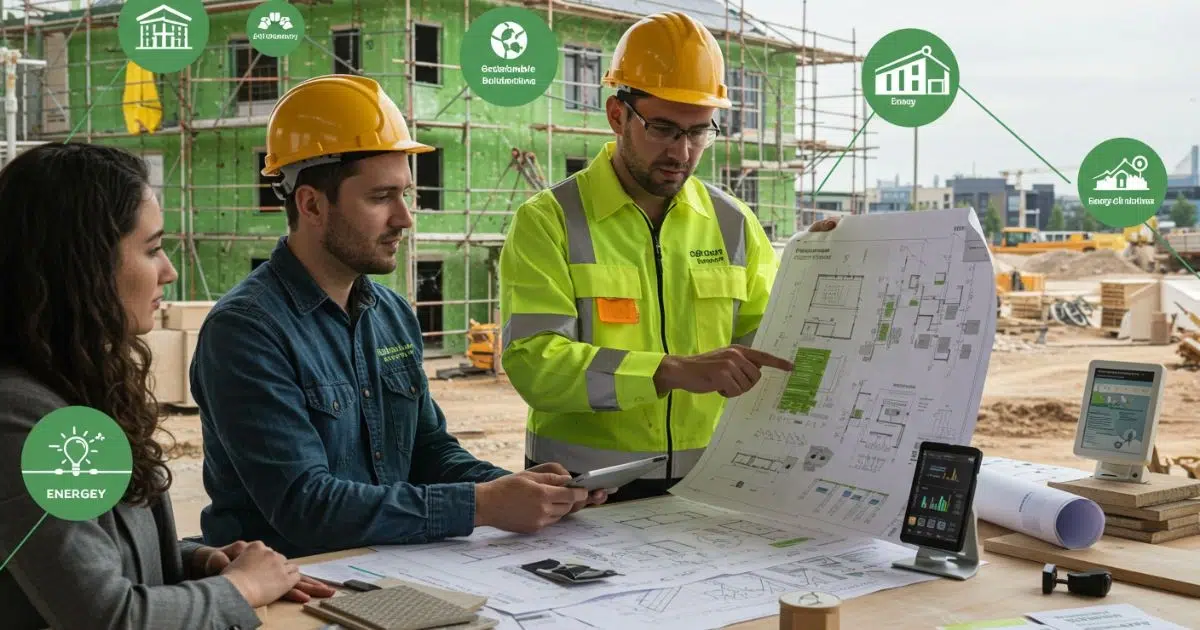
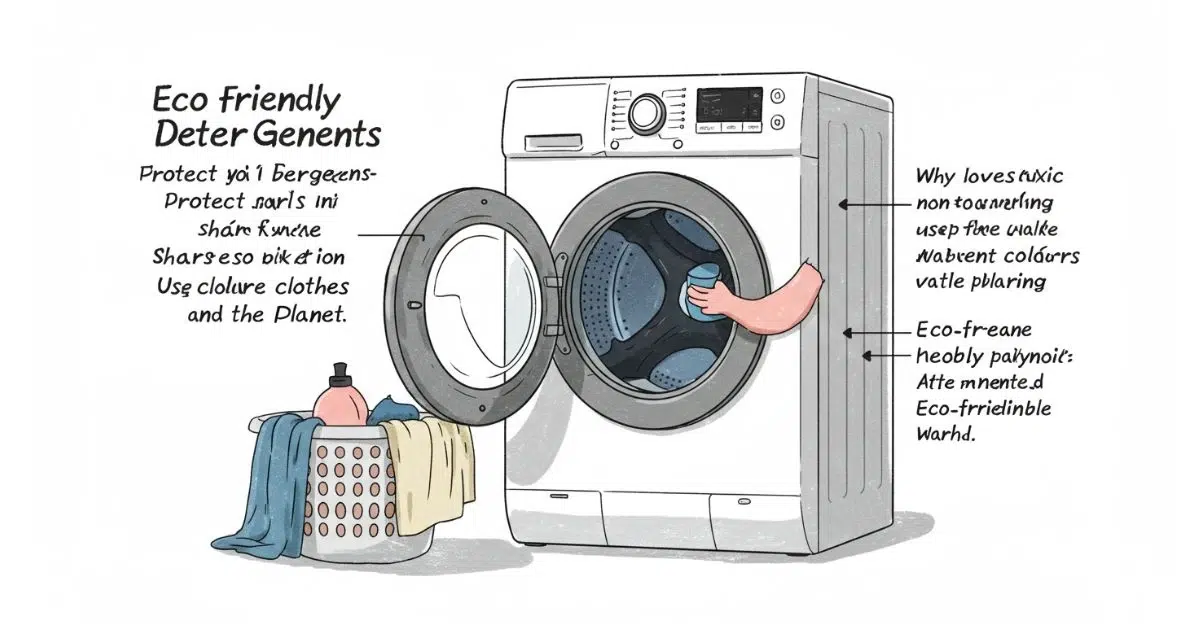
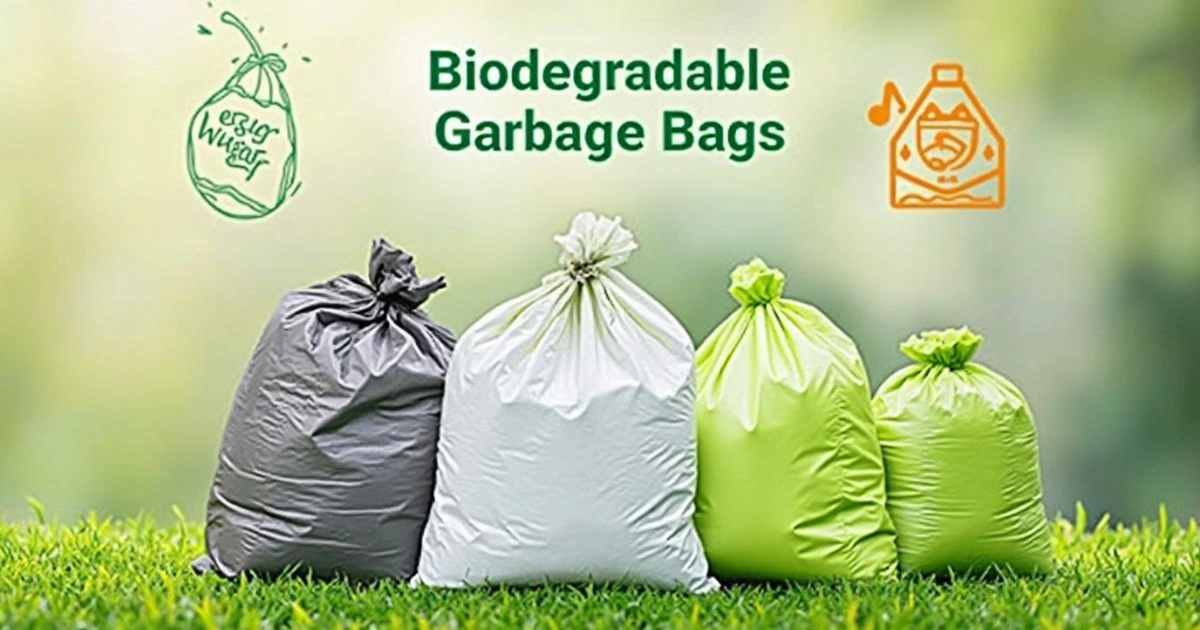
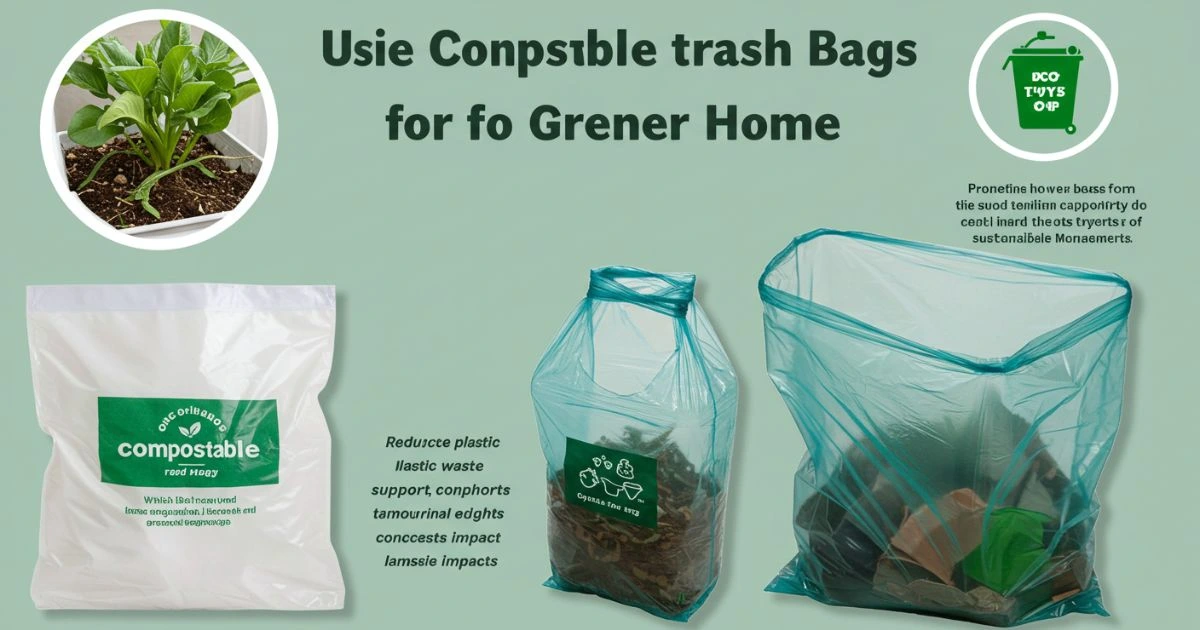

Leave a Reply